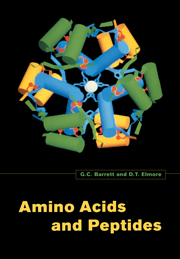Book contents
- Frontmatter
- Contents
- Foreword
- 1 Introduction
- 2 Conformations of amino acids and peptides
- 3 Physicohemical properties of amino acids and peptides
- 4 Reactions and analytical methods for amino acids and peptides
- 5 Determination of the primary structure of peptides and proteins
- 6 Synthesis of amino acids
- 7 Methods for the synthesis of peptides
- 8 Biological roles of amino acids and peptides
- 9 Some aspects of amino-acid and peptide drug design
- Subject index
6 - Synthesis of amino acids
Published online by Cambridge University Press: 05 June 2012
- Frontmatter
- Contents
- Foreword
- 1 Introduction
- 2 Conformations of amino acids and peptides
- 3 Physicohemical properties of amino acids and peptides
- 4 Reactions and analytical methods for amino acids and peptides
- 5 Determination of the primary structure of peptides and proteins
- 6 Synthesis of amino acids
- 7 Methods for the synthesis of peptides
- 8 Biological roles of amino acids and peptides
- 9 Some aspects of amino-acid and peptide drug design
- Subject index
Summary
General
There is an abundant supply of l-enantiomers of most of the coded amino acids. These are made available through large-scale fermentative production in most cases, and also through processing of protein hydrolysates. The early sections of this chapter cover this aspect, However, laboratory synthesis methods are required for the provision of most of the other natural amino acids and for all other amino acids, so the main part of this chapter deals with established syntheses.
Commercial and research uses for amino acids
In addition to the provision of supplies of common amino acids, there are growing needs for routes to new amino acids, since pharmaceutically useful compounds of this class continue to be discovered, which must be free from toxic impurities and homochirally pure in this particular context. Important functions for close analogues of coded and other biologically significant amino acids include enzyme inhibition and retarding the growth of undesirable organisms (fungistatic, antibiotic and other physiological properties, possessed either by the free amino acids or by pep-tides containing them). Free amino acids that perform in this way are α-amino iso-butyric acid (an example of an a-methylated analogue of a coded amino acid), which has been proposed for the control of domestic wood-rotting fungi), and α-methyl-Dopa (α-methyl-3′,4′-dihydroxy-l-phenylalanine), a well-known treatment for Parkinson's disease. Similar success for new therapeutic amino acids, based on their enzyme-inhibition properties, is indicated for amino acids with a minimal structural change such as the substitution of a side-chain hydrogen atom by a fluorine atom.
- Type
- Chapter
- Information
- Amino Acids and Peptides , pp. 120 - 129Publisher: Cambridge University PressPrint publication year: 1998



